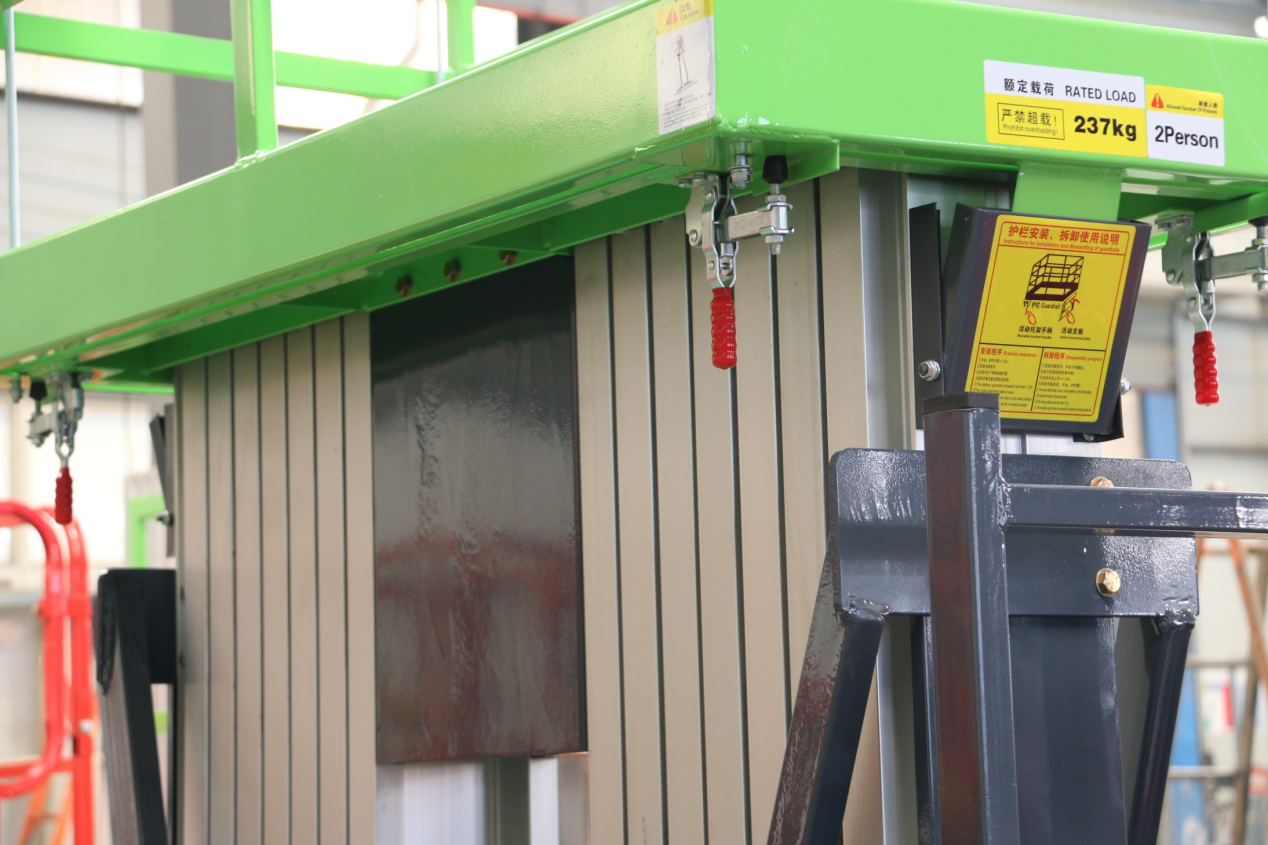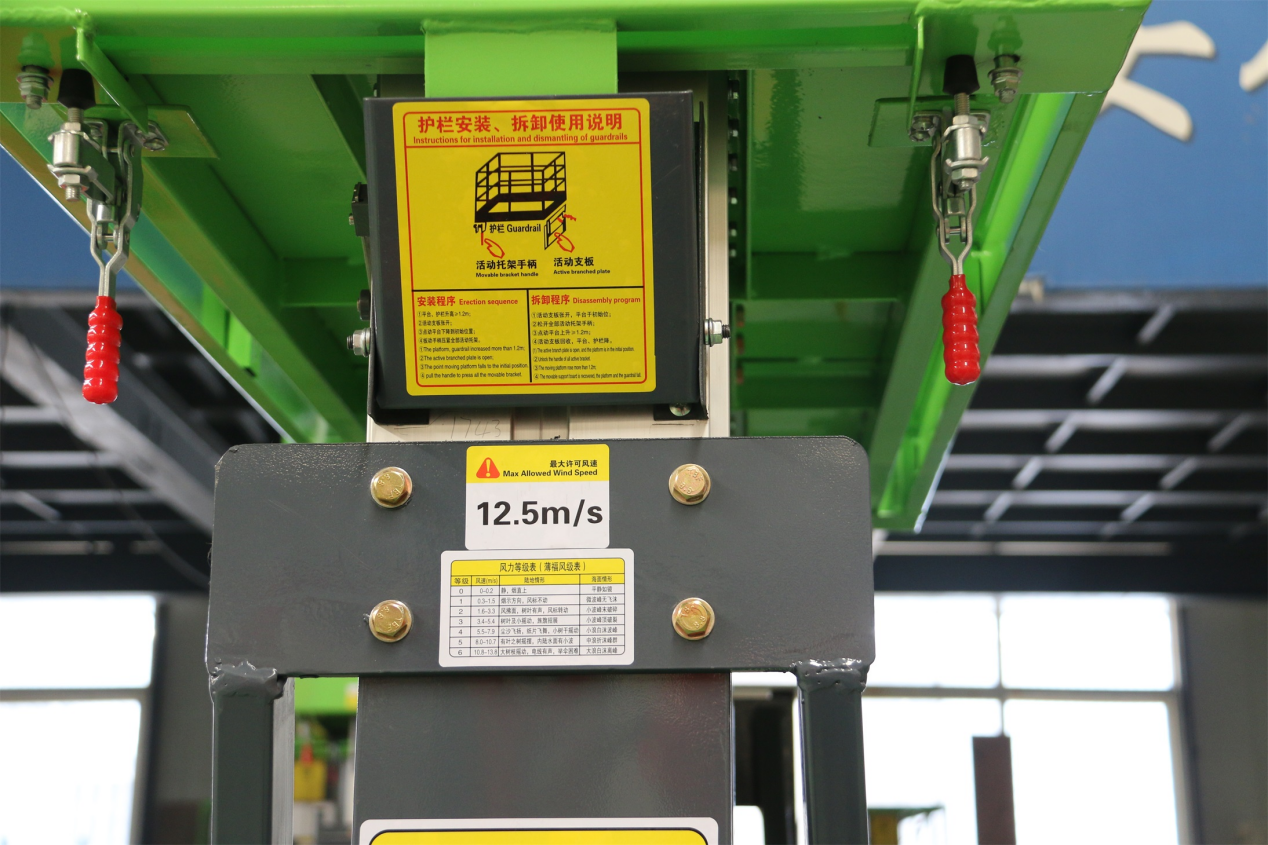1. Anti-fall safety device
The anti-falling safety device is an important part of the construction hoist, and it is necessary to rely on it to eliminate the occurrence of the cage falling accident and ensure the safety of the occupants. Therefore, the factory test of the anti-fall safety device is very strict. Before leaving the factory, the legal inspection unit will measure the torque, measure the critical speed, and measure the spring compression. Each unit is accompanied by a test report and assembled on the construction elevator. Afterwards, the drop test under the rated load is carried out, and the lifts in use on the construction site must be dropped every three months. For anti-falling safety devices that have been manufactured for two years (the date of delivery on the anti-falling safety device), they must also be sent to a legal inspection unit for inspection and testing, and then tested once a year. However, few people submit for inspection. Some construction sites do not even do a drop test every three months, thinking that their anti-fall safety devices are okay, but once an accident occurs, they regret it. Why not test and submit for inspection regularly according to the system? It is good if the user unit blindly thinks that it is not bad. In fact, the quality of the anti-falling safety device can only be judged through testing and inspection. It is impossible to determine whether it is good or bad in daily operation. For those anti-falling safety devices that have been in service over time, it is recommended to submit for inspection earlier and regularly. Experiments are good, and only by knowing what is in mind can we prevent serious accidents before they happen.
2. Safety switch
The safety switches of the lift are all designed according to safety needs, including fence door limit, cage door limit, top door limit, limit switch, upper and lower limit switch, counterweight anti-break rope protection switch, etc. In some construction sites, in order to save trouble, some limit switches are artificially cancelled and short-circuited or not repaired in time after they are damaged, which is equivalent to canceling these safety lines of defense and planting hidden accidents. Example: The hanging cage needs to be loaded with long things, and the hanging cage cannot fit inside and needs to be extended out of the hanging cage, and the door limit or top door limit is artificially cancelled. In the case of imperfect or incomplete safety facilities mentioned above, still carry people and loads This kind of illegal operation is a joke on human lives. In order to avoid the occurrence of hidden dangers of accidents, it is hoped that the leaders of the unit will strengthen management, strictly require elevator maintenance and operators to regularly check the safety and reliability of various safety switches to prevent accidents.
3. Wear and replacement of gears and racks
Construction on the construction site, the working environment is harsh, cement, mortar, and dust cannot be eliminated. The gears and racks are ground each other, and the teeth are still in use after they are sharpened. This should be paid attention to. As we all know, the tooth profile should be like a cantilever beam. When worn to a certain size, the gear (or rack) must be replaced. To what extent should I stop using it and replace it with a new one? The 25-50mm common normal micrometer can be used for measurement. When the length of the common normal of the gear is worn from 37.1mm to less than 35.1mm (2 teeth), a new gear must be replaced. When the rack is worn, measured by the tooth thickness caliper, when the chord height is 8mm, the tooth thickness is worn from 12.56mm to less than 10.6mm. The rack must be replaced. However, there are many “old teeth” gears and rack elevators on the construction site. It is still in overdue service. For safety reasons, new parts must be replaced.
4. Definition of duty cycle
The elevators on the construction site are frequently operated and the utilization rate is high, but the problem of the intermittent working system of the motor has to be considered, which is the problem of the temporary load rate (sometimes called the load duration rate), which is defined as FC=work cycle time/load Time × 100%, where the working cycle time is the load time and the down time. The lifts on some construction sites are rented by leasing companies and always want to make full use of them. However, the temporary load rate of the motor (FC=40% or 25%) is completely ignored. Why doesn’t the motor generate heat? Some of them are still in use even with a burnt smell, which is a very abnormal operation. If the transmission system is poorly lubricated or running resistance is too large, overloaded, or frequently started, it is even a small horse-drawn cart. Therefore, every driver on the construction site must understand the concept of duty cycle and act according to scientific laws. This kind of motor itself is designed for intermittent operation.
5. Buffer
The last line of defense for the safety of the construction elevator is the buffer on the construction elevator. First, it must be installed. Second, it must have a certain strength, can withstand the impact of the elevator’s rated load, and act as a buffer. And many construction sites, although some are set up, but not enough to play a buffer role, there is no buffer at all on the construction site, this is extremely wrong, I hope that the user will pay attention to the inspection, and do not underestimate this last line of defense.
6. Floor parking safety protection door
Each parking floor of the construction lift shall be equipped with parking safety protection doors. Obviously, if it is not installed as required, construction workers waiting at a high place are prone to accidental fall accidents. When setting the parking safety protection door, the height of the safety protection door should be not less than 1.8m, and the landing door should have an interlocking device. The protection door cannot be opened when the cage is not at the parking position to ensure the safety of the operators. On the construction site, people waiting for the construction elevator can open the safety protection door at any time. This is very dangerous and should be paid attention to.
7. Basic fence
According to the regulations of GB10055, “The basic fence should be equipped with mechanical interlock or electric interlock. The mechanism interlock should make the cage can only be located at the specified position at the bottom, and the basic fence door can be opened. The electric interlock should enable the protective fence to be opened. The cage stops and cannot be started”. There are quite a lot of construction elevators. When the hoisting cage approaches the fence door, the bottom of the hoisting cage presses a beam to move downwards, and the reversing pulley wire rope drives the fence door to open upwards. This is not allowed, and it is easy for those near the fence. People cause harm.
8. Wire rope
The wire rope end of each part should adopt reliable connection methods, such as pouring, braiding, forging, and using wedge-shaped solid parts. The distance between the rope clamps is not less than 6 times the diameter of the wire rope, and the length between the rope head and the last rope clamp is not less than 140mm, and must be tied with thin steel wire. The pulley of the rope clamp is placed on the side of the wire rope when the wire is working, and the U-shaped bolt buckle At the end of the wire rope, the rope clamps shall not be arranged in a staggered manner. The rope clamp shall be fixed before the wire rope is stressed, and then tightened after the force. However, in many construction sites, due to poor safety awareness, when using rope clamps to fix the rope, the number of rope clamps, the distance between the ropes, the length of the end, and the length of the end are arbitrary. They are not according to the standard, resulting in a discount of the joints with only 80%-85% of the fixing strength. Leave a safety hazard.
9. The top control box of the hanging cage
GB10055 stipulates that “the top of the cage should be equipped with a control box for maintenance or disassembly, and it has to be allowed to run at a speed not higher than 0.65m/s under the condition of multiple speeds. When using the top control box of the cage At this time, other operating devices will not work. At this time, the safety device of the cage still plays a protective role. The top control of the cage should be operated with a constant pressure button or a bistable switch, and the top of the cage should be installed with a non-self-resetting emergency stop The switch can cut off the circuit at any time and stop the action of the cage”. This article is mainly for SC type construction elevators. Few companies’ products can meet the five requirements of this article at the same time: including products designed by some well-known design units. What are the disadvantages of not meeting these five requirements? It is possible that a safety accident may be caused by the misoperation of the installation and maintenance personnel. It is hoped that the relevant users will conduct a comparative inspection of the construction hoist, especially the old products, if they do not meet the above regulations, they should actively take measures to transform them.
10. Overvoltage, undervoltage, and fault phase protection
Over-voltage, under-voltage, and phase-failure protection device is when there is a voltage drop, over-voltage, phase or phase failure of the electrical circuit, the protection device will act, and the construction hoist will stop running. Some construction elevator maintenance personnel on the construction site do not promptly eliminate the faults that cause the overvoltage and undervoltage fault phase protection devices to operate, but cancel or short-circuit the protection devices to make them inoperative, leaving hidden accidents for the equipment, and some early The product does not have this protective device at all, and it is recommended that it should be equipped. The construction hoist should be able to carry people and goods under the conditions of reliable and effective protection devices for overvoltage and undervoltage and fault phase failure
Post time: Jun-30-2021



